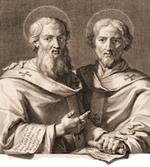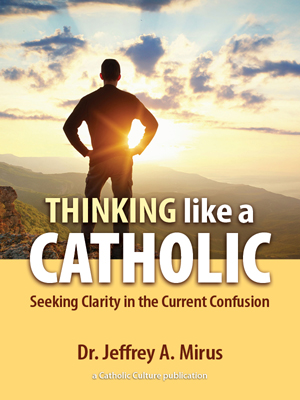Catechism of the Catholic Church
1179 The worship "in Spirit and in truth" 53 of the New Covenant is not tied exclusively to any one place. The whole earth is sacred and entrusted to the children of men. What matters above all is that, when the faithful assemble in the same place, they are the "living stones," gathered to be "built into a spiritual house." 54 For the Body of the risen Christ is the spiritual temple from which the source of living water springs forth: incorporated into Christ by the Holy Spirit, "we are the temple of the living God." 55
1180 When the exercise of religious liberty is not thwarted, 56 Christians construct buildings for divine worship. These visible churches are not simply gathering places but signify and make visible the Church living in this place, the dwelling of God with men reconciled and united in Christ.
1181 A church, "a house of prayer in which the Eucharist is celebrated and reserved, where the faithful assemble, and where is worshipped the presence of the Son of God our Savior, offered for us on the sacrificial altar for the help and consolation of the faithful - this house ought to be in good taste and a worthy place for prayer and sacred ceremonial." 57 In this "house of God" the truth and the harmony of the signs that make it up should show Christ to be present and active in this place. 58
1182 The altar of the New Covenant is the Lord's Cross, 59 from which the sacraments of the Paschal mystery flow. On the altar, which is the center of the church, the sacrifice of the Cross is made present under sacramental signs. The altar is also the table of the Lord, to which the People of God are invited. 60 In certain Eastern liturgies, the altar is also the symbol of the tomb (Christ truly died and is truly risen).
1183 The tabernacle is to be situated "in churches in a most worthy place with the greatest honor." 61 The dignity, placing, and security of the Eucharistic tabernacle should foster adoration before the Lord really present in the Blessed Sacrament of the altar. 62
The sacred chrism (myron), used in anointings as the sacramental sign of the seal of the gift of the Holy Spirit, is traditionally reserved and venerated in a secure place in the sanctuary. The oil of catechumens and the oil of the sick may also be placed there.
1184 The chair of the bishop (cathedra) or that of the priest "should express his office of presiding over the assembly and of directing prayer." 63
The lectern (ambo): "The dignity of the Word of God requires the church to have a suitable place for announcing his message so that the attention of the people may be easily directed to that place during the liturgy of the Word." 64
1185 The gathering of the People of God begins with Baptism; a church must have a place for the celebration of Baptism (baptistry) and for fostering remembrance of the baptismal promises (holy water font).
The renewal of the baptismal life requires penance. A church, then, must lend itself to the expression of repentance and the reception of forgiveness, which requires an appropriate place to receive penitents.
A church must also be a space that invites us to the recollection and silent prayer that extend and internalize the great prayer of the Eucharist.
1186 Finally, the church has an eschatological significance. To enter into the house of God, we must cross a threshold, which symbolizes passing from the world wounded by sin to the world of the new Life to which all men are called. The visible church is a symbol of the Father's house toward which the People of God is journeying and where the Father "will wipe every tear from their eyes." 65 Also for this reason, the Church is the house of all God's children, open and welcoming.
IN BRIEF:
1187 The liturgy is the work of the whole Christ, head and body. Our high priest celebrates it unceasingly in the heavenly liturgy, with the holy Mother of God, the apostles, all the saints, and the multitude of those who have already entered the kingdom.
1188 In a liturgical celebration, the whole assembly is leitourgos, each member according to his own function. The baptismal priesthood is that of the whole Body of Christ. But some of the faithful are ordained through the sacrament of Holy Orders to represent Christ as head of the Body.
1189 The liturgical celebration involves signs and symbols relating to creation (candles, water, fire), human life (washing, anointing, breaking bread) and the history of salvation (the rites of the Passover). Integrated into the world of faith and taken up by the power of the Holy Spirit, these cosmic elements, human rituals, and gestures of remembrance of God become bearers of the saving and sanctifying action of Christ.
1190 The Liturgy of the Word is an integral part of the celebration. The meaning of the celebration is expressed by the Word of God which is proclaimed and by the response of faith to it.
1191 Song and music are closely connected with the liturgical action. The criteria for their proper use are the beauty expressive of prayer, the unanimous participation of the assembly, and the sacred character of the celebration.
1192 Sacred images in our churches and homes are intended to awaken and nourish our faith in the mystery of Christ. Through the icon of Christ and his works of salvation, it is he whom we adore. Through sacred images of the holy Mother of God, of the angels and of the saints, we venerate the persons represented.
1193 Sunday, the "Lord's Day," is the principal day for the celebration of the Eucharist because it is the day of the Resurrection. It is the pre-eminent day of the liturgical assembly, the day of the Christian family, and the day of joy and rest from work. Sunday is "the foundation and kernel of the whole liturgical year" (SC 106).
1194 The Church, "in the course of the year, . . . unfolds the whole mystery of Christ from his Incarnation and Nativity through his Ascension, to Pentecost and the expectation of the blessed hope of the coming of the Lord" (SC 102 § 2).
1195 By keeping the memorials of the saints - first of all the holy Mother of God, then the apostles, the martyrs, and other saints - on fixed days of the liturgical year, the Church on earth shows that she is united with the liturgy of heaven. She gives glory to Christ for having accomplished his salvation in his glorified members; their example encourages her on her way to the Father.
1196 The faithful who celebrate the Liturgy of the Hours are united to Christ our high priest, by the prayer of the Psalms, meditation on the Word of God, and canticles and blessings, in order to be joined with his unceasing and universal prayer that gives glory to the Father and implores the gift of the Holy Spirit on the whole world.
1197 Christ is the true temple of God, "the place where his glory dwells"; by the grace of God, Christians also become temples of the Holy Spirit, living stones out of which the Church is built.
1198 In its earthly state the Church needs places where the community can gather together. Our visible churches, holy places, are images of the holy city, the heavenly Jerusalem, toward which we are making our way on pilgrimage.
1199 It is in these churches that the Church celebrates public worship to the glory of the Holy Trinity, hears the word of God and sings his praise, lifts up her prayer, and offers the sacrifice of Christ sacramentally present in the midst of the assembly. These churches are also places of recollection and personal prayer.
Notes:
English Translation of the Cathechism of the Catholic Church for the United States of America © 1997, United States Catholic Conference, Inc.






